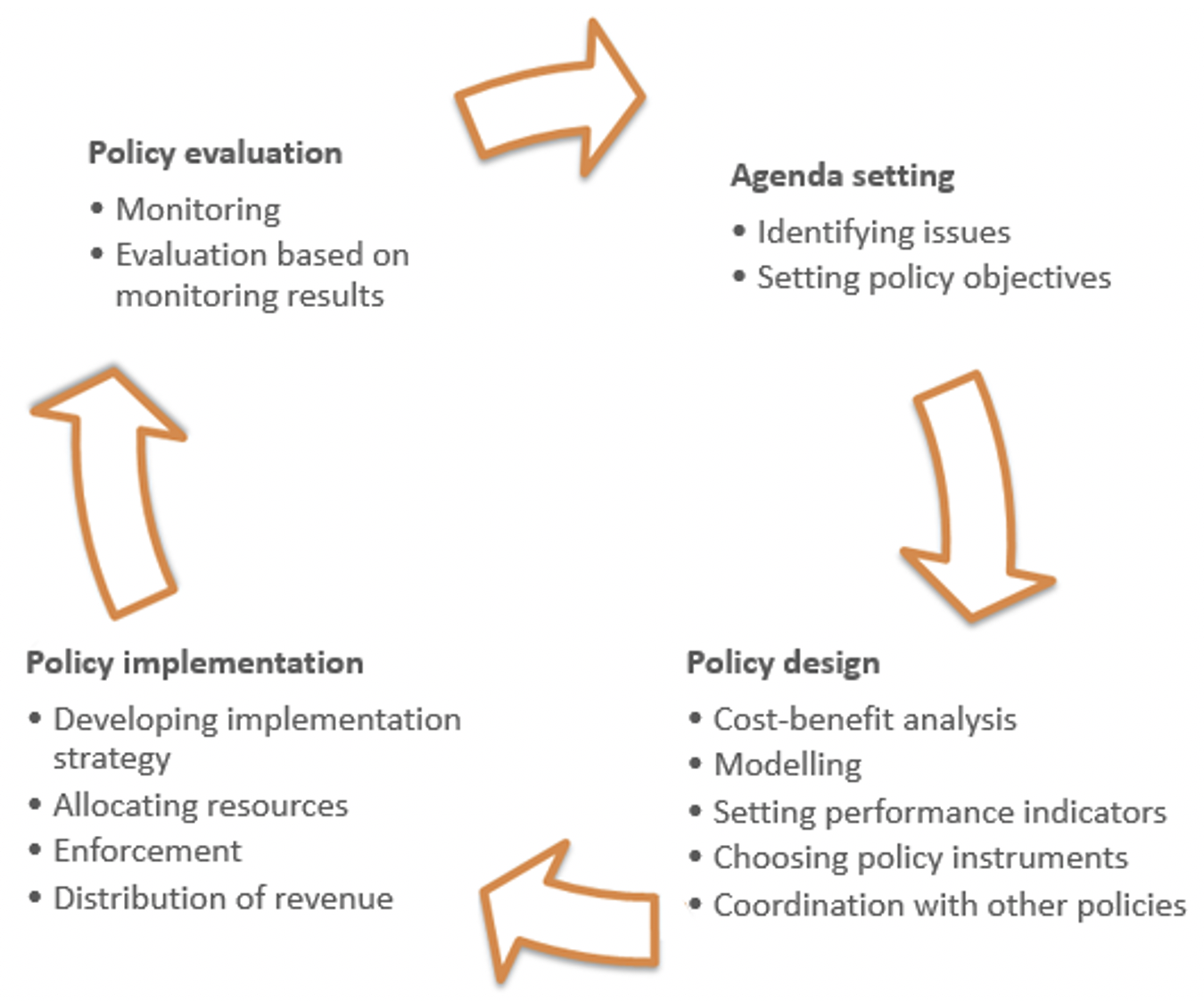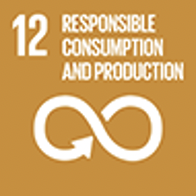
MOOC: Introduction to environmental auditing in the public sector
1.3. Environmental governance tools
Environmental policy instruments
Governments address environmental impact with a variety of instruments ranging from international agreements to national and local governance acts, all of which seek to control, incentivise or monitor environmental and sustainability impact.
Governments’ role in environmental protection is exercised mainly in long-term planning by preparing strategies, regulating sectors by developing legal acts, setting standards, issuing permits and licences and controlling compliance with regulations.
Governments have a number of mechanisms for regulating the environmental behaviour of companies and public, so called regulative instruments, such as international conventions and treaties, policies and programmes, regulatory and administrative instruments, including permits and licensing, Environmental Impact Assessment (EIA), best available technique/technology (BAT), monitoring and control etc.
Besides regulative instruments there are also:
- market-based instruments or economic instruments (e.g. environmental charges and taxes and emission trading schemes)
- voluntary instruments, such as Environmental Management Systems, voluntary reporting, voluntary agreements (e.g. between public and private institutions), award schemes etc.
When auditors study whether governments have managed to organise the activities of companies and citizens in the best possible way, they can focus their audit on these policy instruments and the targets set by governments.
 |
Tip for an auditorWhen you are focusing an audit on policy instruments you can ask, for example:
|
International conventions and treaties
Governments have committed themselves to numerous international environmental and sustainability agreements and conventions. These bring about commitments, but often also significant financial obligations.
Examples of international conventions relevant to environmental auditing:
- The Ramsar Convention on the Preservation of Wetlands (1971)
- The Convention on International Trade in Endangered Species of Wild Fauna and Flora (1973)
- The Vienna Convention and Montreal Protocol to Protect the Ozone Layer (1985)
- The Basel Convention on the Control of Hazardous Waste and their Transfer Across Borders (1989)
- The Convention on Biological Diversity (1992)
- The United Nations Framework Convention on Climate Change (1992)
- The United Nations Convention to Combat Desertification (1994)
- The Rotterdam Convention on the Prior Approval of the Transfer of Hazardous Chemicals (1998)
- The Cartagena Protocol on Biosafety (2000)
- The Stockholm Convention on Persistent Organic Pollutants (2001)
 |
Tip for an auditorCommitments deriving from such agreements may serve auditors as criteria. Read more in UNEP, INTOSAI-WGEA (2010) Auditing the Implementation of Multilateral Environmental Agreements (MEAs): A Primer for Auditors. |
Policies and programmes
Governments formulate national and sector policies, often in the form of strategies, development plans and action plans. The policy design cycle starts by identifying the issues that need to be addressed, continues with policy design, implementation and enforcement and is completed with policy evaluation. It is good practice to involve different stakeholders and interest groups in this process to ensure that all important issues are considered and policies are built on the comprehensive understanding of stakeholders. Broad discussion increases acceptance of an adopted policy and secures the best results.

Policy design cycle (INTOSAI WGEA, 2016)
Major environmental areas usually have separate comprehensive strategies – for example, the water strategy, the tourism strategy, the long-term energy plan, the forest management strategy and the programme to increase the share of renewables in the energy mix.
Strategies set long-term strategic targets for a given sector. Short-term targets and concrete action are usually compiled in an action plan. Strategic documents can be given different names; sometimes strategies and action plans are combined in one document.
 |
Thinking exerciseFind out what are the major environmental strategies and plans in your country. Write the titles of these documents down for yourself. |
 |
Tip for an auditorMost of the countries have joined international environmental agreements, thereby these commitments are usually transformed into national programmes and can serve as audit criteria. If your country has not yet joined the international agreement, it could still be referred in audit as internationally accepted good practice or goal. |
Regulatory and administrative instruments
Regulatory/administrative instruments (also called ‘command-and-control instruments’) set clear conditions and Regulatory/administrative instruments (also called ‘command-and-control instruments’) set clear conditions for achieving goals. Such instruments include regulations, bans, permits and standards.
Environmental standards are a good example of regulatory instruments, for example:
- air quality (e.g. concentration of particular matter PM10 in 24 hours, 50 μg/m3)
- water quality (e.g. concentration of phosphorus (P) in effluence of wastewater treatment plant shouldn’t exceed 0.5 mg/litre )
Standards may specify the desired state of the environment (for example, good status of water bodies) or set limits on pollution/damage (for example, 0.5 mg/litre P in waste water effluent).
 |
Tip for an auditorSpecific environmental quality standards are often defined in numbers and are therefore ideally suited to measuring. Environmental standards are good sources of audit criteria. |
Permits, licences and agreements regulate the relationship between the government and companies.
A government can set various conditions for activities that may have an adverse effect on the environment, including:
- limits on pollution (national legislation, international treaties, environmental standards, etc.)
- measures for mitigation of environmental impact
- conditions for monitoring (e.g. emissions into air)
- requirement to use Best Available Technique for specified activities
- requirements regarding reporting and arranging supervision so as to determine whether permit conditions are being fulfilled.
In environmental audits auditor often comes across environmental permits, licences or agreements, which contain useful information about the activity under scrutiny. Sometimes there is a problem that such documents are missing.
 |
Audit example
NAO Estonia used the data in extraction permits in its audit of mineral resources. The activities of state authorities in organising the extraction of mineral resources used in construction (sand, gravel, limestone and dolomite) were audited. Results: “Surveillance of mining has been insufficient. The mining reports submitted by extractors are not checked properly, which means that the actual quarried amounts may be considerably larger than shown. Cases like these cause damage to the environment, the state does not receive the correct fee for mining rights, the data on the natural resources balance sheet show the remaining stock as being larger than it actually is and fair competition between mining companies is not guaranteed” (read more). |
 |
Tip for an auditorAn auditor can study the process of issuing permits (e.g. if the impact of planned activities on the environment is weighed up and proper mitigation measures are set or if monitoring and reporting conditions are set). Auditors can analyse whether it is checked that all companies who should have a permit have actually obtained one. Environmental permits may come with conditions, which are good sources of audit criteria. |
Environmental Impact Assessment
An Environmental Impact Assessment (EIA) is an evaluation of potential positive or adverse impact that a proposed project may have on the environment. The assessment takes into consideration the environmental, social and economic aspects of the project.
The term EIA refers to both a decision-making process and a document deriving from the evaluation process. However, some critics say that an EIA is used as a decision-aiding rather than a decision-making tool.
EIA requirements can vary from country to country. National law often sets conditions on conducting an EIA:
- projects that need to be assessed (size of the project)
- conditions regarding how to make assessments (who makes them and at which stage of a project)
- aspects of the environment likely to be significantly affected by the proposed project
- significant impact arising from the project and evaluation of alternatives
- measures for the prevention and mitigation of significant impact
- social and economic impact
Auditors obtain the relevant information by studying the EIA process and EIA reports. The conditions set out in EIA reports are often added to the permits issued to enterprises/developers.
A Strategic Environmental Assessment (SEA) is a systematic decision support process which aims to ensure that environmental and, where possible, other sustainability aspects are considered effectively in developing policies, plans and programmes.
Both EIAs and SEAs are instruments that build on the precautionary principle.
 |
Tip for an auditorEIA and SEA procedures and reports are useful sources of information in all environmental audits, where applicable. Therefore, an environmental auditor should be familiar with the national requirements of EIAs and SEAs. |
Best Available Techniques
Best Available Techniques or Technology (BAT) requires the enterprise/operator to use the best possible economically justifiable technology to protect the environment. BAT is not a ‘spare no expense’ approach that always demands the use of the best technology available regardless of the cost-benefit analysis – in practice, the cost aspect is also taken into consideration.
The BAT concept was first used in the 1992 OSPAR Convention for the Protection of the Marine Environment of the North-East Atlantic for all types of industrial installations. BAT is mentioned in several EU Directives and legal documents in other countries (including the United States). It has acquired the status of customary law. BAT reference documents have been drafted, for example for food industry, energy production, heavy industry, chemicals industry.
 |
Tip for an auditorBAT reference documents can be used as a source of criteria or for developing audit recommendations. Environmental agencies in many countries store BAT reference documents (BREFs), which are most easily found via an Internet search. See European BAT reference documents (BREFs) |
Monitoring and control
Environmental monitoring involves the collection of data at certain intervals and analysing the data to identify trends. Monitoring should be taken into consideration by decision-makers in order to correct policy, where necessary. It is good practice to make monitoring data available to the general public.
 |
Audit example
Content and scope of the report: This report sets out our expectations of good practice for an effective system of performance metrics based on our experience of reviewing government approaches to managing performance. It also examines the government’s current environmental metrics and its plans for developing new metrics. We focus on the metrics that relate to England or are UK-wide. Report conclusions: Successive governments have done a lot to raise the profile of environmental issues, and the publication of a 25-year plan for improving the natural environment within a generation could mark a step-change in approach. The government’s draft framework for tracking progress against these environmental ambitions is promising. While significant challenges still need to be overcome, it is encouraging that the initial work is taking a broad, ‘whole system’ view. A critical test will be whether there is strong ‘whole of government’ ownership of the new framework of metrics, with all parts of the government actually using this information to monitor progress and take action if performance is not improving as quickly as expected. To enable continuous improvement, it will be important that public reporting on progress is transparent and accessible in order to engage the wider community in challenge and public debate. And the new environmental watchdog needs to be demonstrably independent to provide strong external scrutiny (read more). |
Controlling the behaviour of companies and inhabitants is necessary to ensure compliance with regulations. This is usually done by the environmental inspectorate. Sometimes municipalities also have a role in controlling compliance with environmental regulations. Lack of data on environmental conditions is often a major obstacle in audits. In some cases it makes sense to contract experts to collect data.
 |
Tip for an auditorThe availability of monitoring data should be checked by auditors, as environmental monitoring data provides useful information about environmental performance. You may also pay attention whether monitoring reports are publicly available. |
Market-based instruments
Market-based instruments (MBIs; also called economic instruments) are taxes, charges, levies, tradable permit schemes, deposit refund systems, subsidies, liability schemes and more. These instruments can be used to provide producers and consumers with incentives to change their behaviour towards the more efficient use of natural resources by reducing consumption and to look for more effective ways of making environmental progress while providing them with flexibility in how they do so.
Governments use market-based instruments to guide the behaviour of companies and citizens and to address the market failure of external costs or so-called ‘environmental externalities’. Externalities refer to situations where the production or consumption of goods and services imposes costs (negative externality) or benefits (positive externality) on others which are not reflected in the prices charged for the goods and services being provided (OECD, 2008).
Such costs include, for example:
- the cost of disposing of a product at the end of its useful life
- the environmental degradation caused by the emissions, pollutants and waste created during production
- the cost of health problems caused by toxic substances
Some subsidies are environmentally harmful. These are defined by OECD as a result of a government action that confers an advantage on consumers or producers, in order to supplement their income or lower their costs, but in doing so, discriminates against sound environmental practices.
Environmentally harmful subsidies can be direct budgetary transfers, tax exemptions and rebates, market price support etc. These are present in all sectors of the economy. The most common areas where such subsidies exist include energy, transport and agriculture.
 |
Audit example
The review describes whether and how environmentally harmful economic measures and their impact have been identified and assessed in Estonia, and what steps have been taken to modify or eliminate the incompatible measures. Based on international experience (through examples from internationally developed methodologies and other countries), it has been described how environmentally harmful economic measures could be identified, assessed, modified or disposed of. (read more). |
Phasing out environmentally harmful subsidies is related to SDG 12, target 12.c: Rationalise inefficient fossil-fuel subsidies that encourage wasteful consumption by removing market distortions in accordance with national circumstances, including by restructuring taxation and phasing out those harmful subsidies, where they exist, to reflect their environmental impacts [—]. Indicator 12.c.1: Amount of fossil-fuel subsidies per unit of GDP (production and consumption) and as a proportion of total national expenditure on fossil fuels.
 |
Thinking exerciseCan you name three potentially environmentally harmful subsidies/tax exemptions in your country? |
Market-based instruments provide solid financial data for auditing. It is possible to study how well an instrument is implemented, how effectively a levy is collected or how often fines are issued or whether it changes behaviour (which is usually the main aim of the instrument), etc.
 |
Reading suggestion!INTOSAI WGEA (2016) ‘Market-based instruments for environmental protection and management’. From this report you can find several examples of auditing market based instruments. |
 |
Tip for an auditorAn audit could be designed to measure the efficiency or/and effectiveness of a government’s economic instruments in achieving the desired result (e.g. reducing greenhouse gas emissions). |
Voluntary instruments
Besides regulatory and market based instruments, there are also voluntary schemes for encouraging better environmental behaviour.
An Environmental Management System (EMS) is a voluntary tool with which organisations/enterprises can manage and improve their environmental performance. An EMS helps organisations identify environmental impact and risks in order to incorporate them in the decision-making process in line with financial aspects. An EMS requires an organisation to set itself targets for continuous improvement in performance and to monitor achievements.
The most widely known EMSs are:
- ISO 14001, a standard which is recognised and used globally
- Eco-Management and Audit Scheme (EMAS), which is mostly oriented towards organisations of EU Member States
There are also ‘lighter’ versions of environmental management systems, e.g. Green Office initiatives.
However, having either of these systems indicates that an organisation has set an environmental policy, identified its significant environmental impact and set targets and an action plan to minimise the impact and regularly reviews its environmental performance. Usually, the system is verified by an independent certification body, which gives extra credits to the system.
Organisations implementing either ISO 14001 or EMAS have better data and a better understanding of their environmental responsibilities. Therefore, the use of voluntary environmental schemes should be encouraged.
 |
Reading suggestion!Have a look at the INTOSAI WGEA research paper on Greening SAIs (2016). |
Voluntary reporting on organisations’ environmental performance is gaining recognition. Besides environmental reporting, there are broader sustainability and corporate social responsibility reports that cover social issues. Sustainability reporting is gaining followers among companies that want to demonstrate responsibility and present measures they have taken in both the environmental and social spheres. Such criteria are often also consolidated under the acronym ESG (environmental, social and corporate governance).
 |
Reading suggestion!Sustainability Reporting: Concepts, Frameworks and the role of Supreme Audit Institutions (INTOSAI WGEA, 2013). |
If the (public) organisation or company has a certified EMS, it is secured that they meet environmental legislation, have analysed their environmental impacts and set a plan to reduce them. These organisations are more transparent in their environmental action and reporting.
In addition, there can be between public and private sector voluntary environmental agreements, an alternative to legislative instruments – agreements among the corporate, government and/or non-profit sectors not required by legislation that aim to improve environmental quality or the use of natural resources.
There are also many environmental local/sectoral/national/international award schemes, which aim to encourage the public and private sector or civil society to take voluntary steps to have a positive impact on the environment, for example the UN Champions of the Earth.


 NAO Estonia (2009) National arrangement of mining mineral resources used in construction.
NAO Estonia (2009) National arrangement of mining mineral resources used in construction.
